Have you become that your Edge, Internet Explorer, Chrome and Mozilla Firefox constantly redirects to the Email Anytime homepage instead of your homepage? Then it’s possible that your current settings of internet browsers changed and your machine has been hijacked by the undesired software from the browser hijacker family. Perform the step-by-step instructions below as quickly as possible to get rid of Email Anytime search and protect you from other browser hijackers and potentially undesired programs.
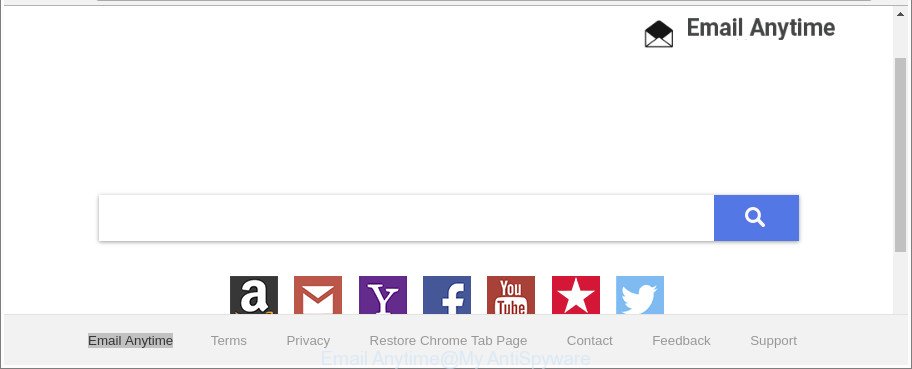
The “Email Anytime” makes changes to browser settings
The Email Anytime hijacker takes over your web-browser’s default search engine and controls what will be displayed to you whenever you do a searching. Other than the search results, it also provides a large count of intrusive ads on the search page. Some of these advertisements designed to mislead you into buying certain questionable products and apps. Moreover, sometimes, those advertisements could redirect you to misleading or harmful web-pages.
Some browser hijackers also contain ‘ad-supported’ software (also known as adware) that has the ability to display annoying ads or collect a wide variety of personal information about you that may be sold to third parties. These unwanted advertisements can be opened in the form of pop-unders, pop-ups, in-text advertisements, video ads, text links or banners or even massive full page advertisements. Most of the ad supported software is made to show advertisements, but some adware is form of spyware that often used to track users to collect lots of confidential info about you.
Therefore it’s very important to free your PC of browser hijacker as soon as possible. Follow the few simple steps below to remove Email Anytime search, as well as other malicious software and adware, which can be installed onto your PC along with it.
Remove Email Anytime from Google Chrome, Firefox, IE, Edge
The answer is right here on this page. We have put together simplicity and efficiency. It will help you easily to free your personal computer of hijacker infection. Moreover, you may select manual or automatic removal method. If you’re familiar with the computer then use manual removal, otherwise use the free anti malware tool developed specifically to remove browser hijacker like Email Anytime. Of course, you may combine both methods. Read it once, after doing so, please print this page as you may need to shut down your web browser or restart your machine.
To remove Email Anytime, execute the steps below:
- How to remove Email Anytime manually
- Email Anytime redirect automatic removal
- Stop Email Anytime redirect and other unwanted web-sites
- How did you get infected with Email Anytime browser hijacker infection
- To sum up
How to remove Email Anytime manually
The following instructions is a step-by-step guide, which will help you manually delete Email Anytime start page from the MS Edge, Google Chrome, Mozilla Firefox and Internet Explorer.
Delete potentially unwanted applications using Windows Control Panel
Some programs are free only because their setup file contains a hijacker such as the Email Anytime. This unwanted applications generates profit for the authors when it is installed. Many browser hijackers can be removed by simply uninstalling them from the ‘Uninstall a Program’ that is located in Windows control panel.
Windows 8, 8.1, 10
First, press Windows button

Once the ‘Control Panel’ opens, click the ‘Uninstall a program’ link under Programs category as on the image below.

You will see the ‘Uninstall a program’ panel as displayed below.

Very carefully look around the entire list of applications installed on your computer. Most likely, one of them is the browser hijacker infection responsible for redirecting user searches to Email Anytime. If you have many programs installed, you can help simplify the search of harmful applications by sort the list by date of installation. Once you have found a questionable, unwanted or unused program, right click to it, after that press ‘Uninstall’.
Windows XP, Vista, 7
First, click ‘Start’ button and select ‘Control Panel’ at right panel like below.

When the Windows ‘Control Panel’ opens, you need to click ‘Uninstall a program’ under ‘Programs’ as on the image below.

You will see a list of programs installed on your machine. We recommend to sort the list by date of installation to quickly find the applications that were installed last. Most probably, it’s the hijacker infection that cause Email Anytime web page to appear. If you’re in doubt, you can always check the program by doing a search for her name in Google, Yahoo or Bing. When the application which you need to delete is found, simply click on its name, and then press ‘Uninstall’ as displayed below.

Remove Email Anytime from Firefox by resetting internet browser settings
Resetting your Mozilla Firefox is basic troubleshooting step for any issues with your web-browser program, including the reroute to Email Anytime page. When using the reset feature, your personal information such as passwords, bookmarks, browsing history and web form auto-fill data will be saved.
First, start the Mozilla Firefox and click ![]() button. It will show the drop-down menu on the right-part of the web browser. Further, press the Help button (
button. It will show the drop-down menu on the right-part of the web browser. Further, press the Help button (![]() ) as displayed in the following example.
) as displayed in the following example.

In the Help menu, select the “Troubleshooting Information” option. Another way to open the “Troubleshooting Information” screen – type “about:support” in the browser adress bar and press Enter. It will show the “Troubleshooting Information” page as shown on the screen below. In the upper-right corner of this screen, click the “Refresh Firefox” button.

It will open the confirmation prompt. Further, click the “Refresh Firefox” button. The Mozilla Firefox will begin a task to fix your problems that caused by the browser hijacker responsible for redirects to Email Anytime. After, it’s finished, press the “Finish” button.
Delete Email Anytime search from Google Chrome
In order to be sure that there is nothing left behind, we suggest you to reset Chrome web-browser. It will restore Chrome settings including new tab page, startpage and search engine to defaults.

- First, start the Chrome and press the Menu icon (icon in the form of three dots).
- It will open the Google Chrome main menu. Choose More Tools, then press Extensions.
- You’ll see the list of installed extensions. If the list has the addon labeled with “Installed by enterprise policy” or “Installed by your administrator”, then complete the following tutorial: Remove Chrome extensions installed by enterprise policy.
- Now open the Google Chrome menu once again, click the “Settings” menu.
- Next, press “Advanced” link, which located at the bottom of the Settings page.
- On the bottom of the “Advanced settings” page, press the “Reset settings to their original defaults” button.
- The Google Chrome will display the reset settings prompt as shown on the image above.
- Confirm the web-browser’s reset by clicking on the “Reset” button.
- To learn more, read the post How to reset Chrome settings to default.
Delete Email Anytime search from Microsoft Internet Explorer
First, open the Internet Explorer, then press ‘gear’ icon ![]() . It will open the Tools drop-down menu on the right part of the browser, then click the “Internet Options” as shown on the image below.
. It will open the Tools drop-down menu on the right part of the browser, then click the “Internet Options” as shown on the image below.

In the “Internet Options” screen, select the “Advanced” tab, then click the “Reset” button. The Internet Explorer will show the “Reset Internet Explorer settings” dialog box. Further, press the “Delete personal settings” check box to select it. Next, press the “Reset” button as displayed in the figure below.

When the task is finished, press “Close” button. Close the IE and restart your machine for the changes to take effect. This step will help you to restore your web browser’s new tab page, startpage and default search engine to default state.
Email Anytime redirect automatic removal
Manual removal tutorial does not always allow to completely remove the hijacker infection, as it is not easy to identify and delete components of browser hijacker and all malicious files from hard disk. Therefore, it’s recommended that you run malware removal utility to completely delete Email Anytime off your PC system. Several free malicious software removal tools are currently available that may be used against the hijacker infection. The optimum method would be to use Zemana, MalwareBytes Anti Malware (MBAM) and HitmanPro.
Run Zemana to remove browser hijacker infection
We suggest you to run the Zemana Anti Malware (ZAM) which are completely clean your computer. Moreover, the utility will help you to delete PUPs, malicious software, toolbars and ad-supported software that your computer may be infected too.

- Visit the following page to download the latest version of Zemana Anti Malware for Microsoft Windows. Save it on your Desktop.
Zemana AntiMalware
164782 downloads
Author: Zemana Ltd
Category: Security tools
Update: July 16, 2019
- At the download page, click on the Download button. Your web-browser will show the “Save as” prompt. Please save it onto your Windows desktop.
- Once the downloading process is finished, please close all apps and open windows on your system. Next, start a file called Zemana.AntiMalware.Setup.
- This will open the “Setup wizard” of Zemana Anti Malware onto your computer. Follow the prompts and do not make any changes to default settings.
- When the Setup wizard has finished installing, the Zemana will run and show the main window.
- Further, click the “Scan” button to perform a system scan for the hijacker infection responsible for redirecting user searches to Email Anytime. A scan can take anywhere from 10 to 30 minutes, depending on the count of files on your computer and the speed of your personal computer. While the Zemana tool is checking, you may see how many objects it has identified as being infected by malware.
- After the system scan is finished, a list of all threats detected is created.
- Once you’ve selected what you want to delete from your PC system click the “Next” button. The utility will remove browser hijacker related to Email Anytime homepage and move items to the program’s quarantine. After finished, you may be prompted to restart the system.
- Close the Zemana Free and continue with the next step.
Use HitmanPro to delete Email Anytime homepage
HitmanPro is a free utility that can identify hijacker infection which redirects your browser to undesired Email Anytime web page. It is not always easy to locate all the unwanted applications that your PC might have picked up on the Internet. Hitman Pro will scan for the ad supported software, browser hijacker infections and other malicious software you need to uninstall.
HitmanPro can be downloaded from the following link. Save it on your Windows desktop or in any other place.
When the downloading process is done, open the folder in which you saved it and double-click the Hitman Pro icon. It will start the HitmanPro tool. If the User Account Control dialog box will ask you want to open the application, click Yes button to continue.
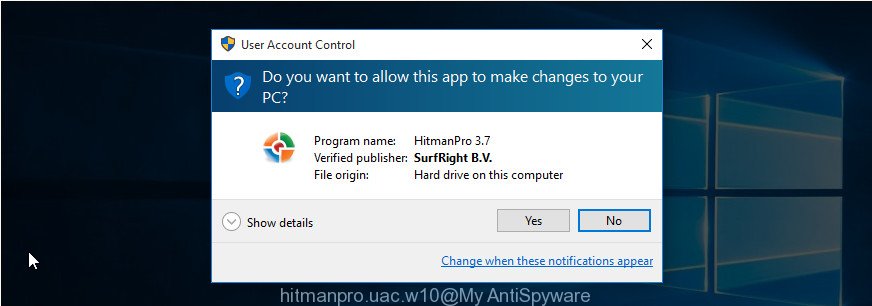
Next, click “Next” to begin checking your PC for the hijacker which developed to redirect your browser to the Email Anytime web site. Depending on your machine, the scan can take anywhere from a few minutes to close to an hour. While the HitmanPro is checking, you may see number of objects it has identified either as being malicious software.
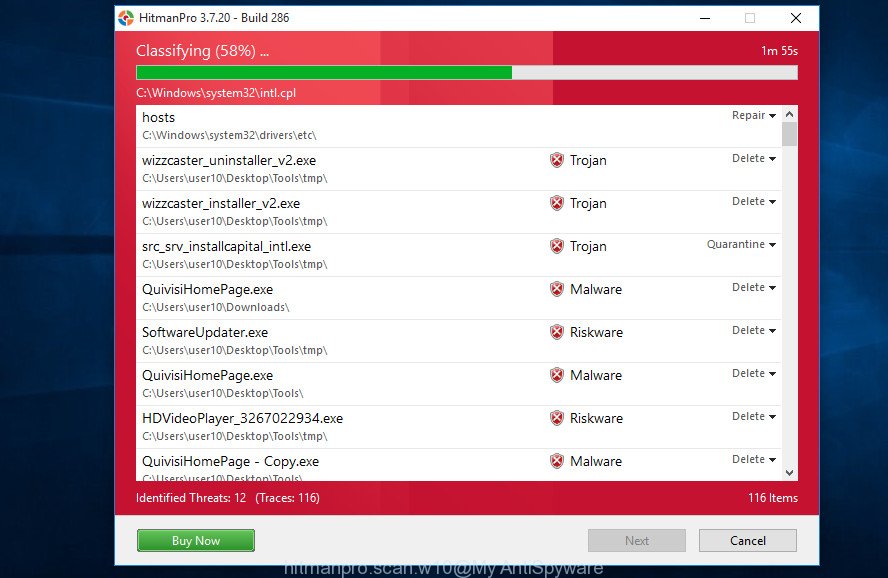
Once that process is finished, HitmanPro will produce a list of undesired and ad-supported software as shown below.
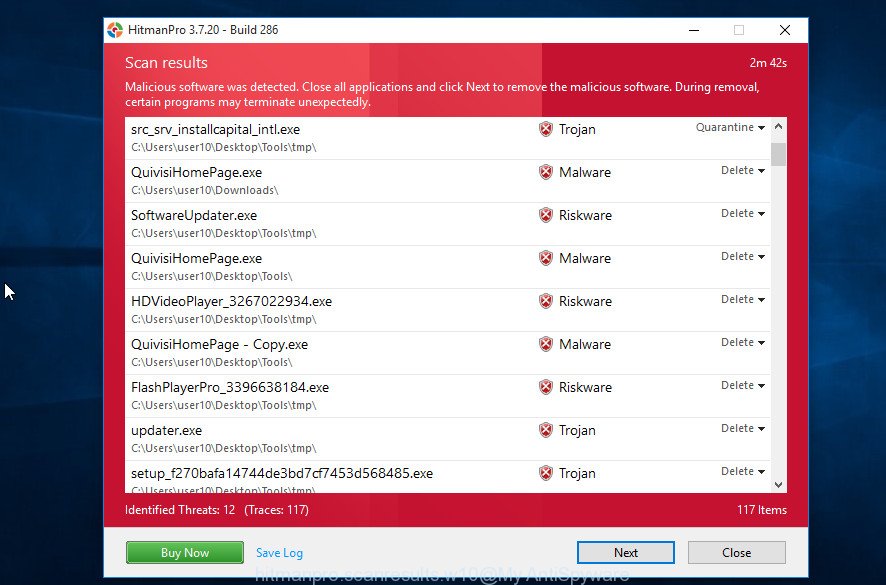
Review the report and then click “Next” button. It will display a dialog box, click the “Activate free license” button. The HitmanPro will begin to get rid of hijacker which cause Email Anytime website to appear. When disinfection is finished, the tool may ask you to restart your personal computer.
How to get rid of Email Anytime with Malwarebytes
You can remove Email Anytime search automatically with a help of Malwarebytes Free. We suggest this free malware removal tool because it can easily delete browser hijackers, adware, potentially unwanted programs and toolbars with all their components such as files, folders and registry entries.
Download MalwareBytes from the following link.
327040 downloads
Author: Malwarebytes
Category: Security tools
Update: April 15, 2020
When the downloading process is done, close all software and windows on your PC. Double-click the install file named mb3-setup. If the “User Account Control” prompt pops up as on the image below, click the “Yes” button.
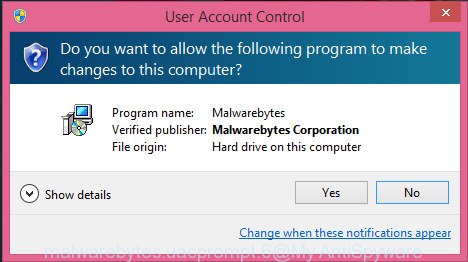
It will open the “Setup wizard” that will help you setup MalwareBytes Free on your personal computer. Follow the prompts and don’t make any changes to default settings.
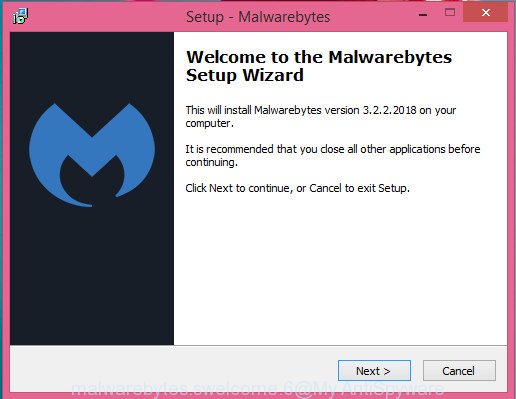
Once installation is done successfully, click Finish button. MalwareBytes will automatically start and you can see its main screen as shown on the screen below.
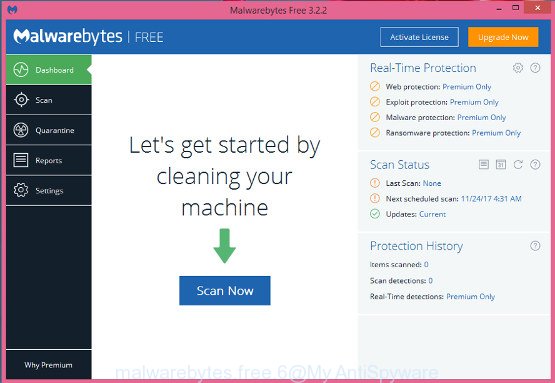
Now click the “Scan Now” button to perform a system scan for the hijacker responsible for redirecting user searches to Email Anytime. Depending on your personal computer, the scan can take anywhere from a few minutes to close to an hour. During the scan MalwareBytes Anti Malware will detect threats exist on your PC.
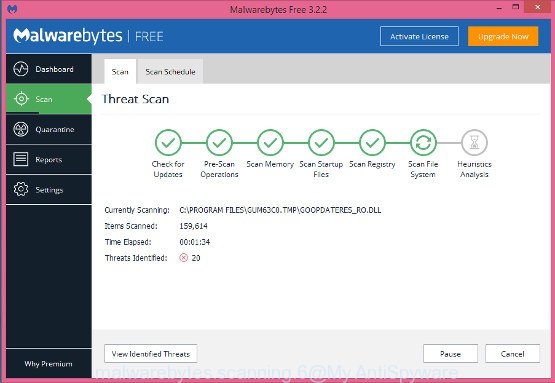
When the scanning is finished, MalwareBytes Free will open a list of found threats. You may delete items (move to Quarantine) by simply click “Quarantine Selected” button. The MalwareBytes Anti Malware (MBAM) will remove hijacker infection responsible for redirecting user searches to Email Anytime and add threats to the Quarantine. When finished, you may be prompted to restart the PC.
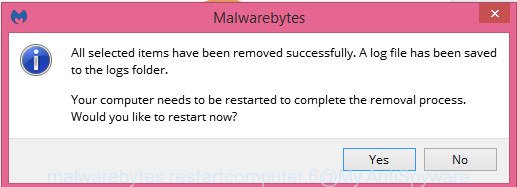
We advise you look at the following video, which completely explains the procedure of using the MalwareBytes to remove adware, hijacker infection and other malicious software.
Stop Email Anytime redirect and other unwanted web-sites
Use ad blocker program like AdGuard in order to block ads, malvertisements, pop-ups and online trackers, avoid having to install harmful and adware browser plug-ins and add-ons which affect your personal computer performance and impact your PC security. Browse the Internet anonymously and stay safe online!
Installing the AdGuard is simple. First you’ll need to download AdGuard on your machine from the link below.
26839 downloads
Version: 6.4
Author: © Adguard
Category: Security tools
Update: November 15, 2018
Once the downloading process is finished, launch the downloaded file. You will see the “Setup Wizard” screen as shown on the image below.

Follow the prompts. When the install is finished, you will see a window as shown on the screen below.

You can press “Skip” to close the install application and use the default settings, or click “Get Started” button to see an quick tutorial that will help you get to know AdGuard better.
In most cases, the default settings are enough and you don’t need to change anything. Each time, when you launch your machine, AdGuard will launch automatically and block popup advertisements, web-pages such as Email Anytime, as well as other harmful or misleading websites. For an overview of all the features of the application, or to change its settings you can simply double-click on the AdGuard icon, that may be found on your desktop.
How did you get infected with Email Anytime browser hijacker infection
The Email Anytime browser hijacker infection spreads with a simple but quite effective way. It is integrated into the installation package of various freeware. Thus on the process of installation, it will infect your web-browser and change it’s settings on the Email Anytime. To avoid browser hijacker, you just need to follow a few simple rules: carefully read the Terms of Use and the license, select only a Manual, Custom or Advanced install type, which enables you to make sure that the program you want to install, thereby protect your computer from the browser hijacker such as the Email Anytime.
To sum up
After completing the steps outlined above, your computer should be free from hijacker which cause Email Anytime web site to appear and other malware. The Chrome, Microsoft Edge, Firefox and Microsoft Internet Explorer will no longer display unwanted Email Anytime site on startup. Unfortunately, if the tutorial does not help you, then you have caught a new hijacker, and then the best way – ask for help in our Spyware/Malware removal forum.




















